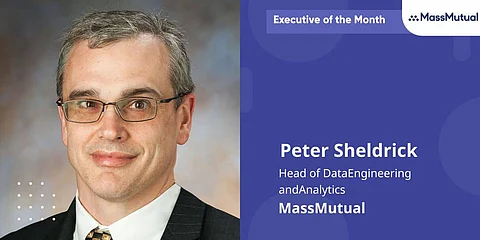

MassMutual is a leading mutual life insurance company that is run for the benefit of its members and participating policy owners. Founded in 1851, the company has been continually guided by one consistent purpose. It helps people secure their future and protect the ones they love. With a focus on delivering a long-term value, MassMutual offers a wide range of protection, accumulation, and wealth management products and services. Peter Sheldrick is currently the Head of Data Engineering and Analytics for MassMutual's Corporate Audit organization. His ambition is to create the future state of internal auditing at MassMutual. He aims to build scalable processes for automated auditing, enabling the auditors to access and analyze data by themselves without his team acting as an intermediary source by using descriptive, predictive, and prescriptive analytics in the audit process. Wrapping around these categories is a significant training component where the environment encompasses formal training, self-service training, and coaching to upskill auditors' capabilities in the area of analytics. To accomplish these goals, he works closely with his peers in the enterprise technology and experience area. He has also utilized the enterprise architecture group to ensure his department's strategy and approach align with the enterprise's goals. His team uses the same patterns and practices instituted by the enterprise data management and delivery group to ensure consistency and limit technical debt.
When Peter began his journey in data science back in 2005, he had quickly recognized the need to collaborate closely with his customers. If the customer does not understand the model then the data scientist must have essentially failed. Often the customer's discussion begins with narrowing the scope of the problem statement and ensuring a thorough understanding of how or where the model will be implemented. In addition, the data scientist must take the time to coach and educate the customer on the utility of the model using non-technical terms. Before 2005, he worked in finance and other operational areas so he understood the insurance business. When Pete builds a data science team, he seeks out knowledge on how the business is run and makes money through mentoring and training opportunities.
Peter experienced difficulty finding a role in data science in 2005 in his non-traditional technical background. He began to read college-level statistics textbooks and academic journal articles, and then he found a mentor in the data science group. In addition, he began building models to demonstrate his understanding and capability in this functional area. Eventually, this approach along with a supportive hiring manager landed him into his first official data science role.
Peter believes a technology leader is accountable for delivering software and services that meet customers' needs while minimizing cost and time. Since business priorities can shift and the technological landscape is in a constant state of flux, the ability to adapt and quickly change the direction is necessary, as is the resiliency to maintain a steady sense of purpose during challenging projects. Finally, the ability to cultivate relationships with the customers by developing a strong understanding of their business while communicating technical concepts by using non-technical terms is the key to success.
Peter makes sure his team takes a balanced approach in delivering products and services for their customers. At times, the customer is clear with their expectations and requirements. Other times, the customer does not possess enough technical knowledge to articulate their desired end state. In this situation, his team mocks up potential solutions and then creates a small demonstration of them. From there, the results are finalized.
Of the focus areas listed, artificial intelligence and automation can have the largest impact on the internal audit function. Generally, audit staff remains relatively flat, but the risks to the enterprise continue to grow. Using automation, audit tests can be deployed to analyze the environment instead of auditors, thereby covering more of the audit universe and providing assurance of the control environment. Machine learning models can be used to aid the auditors in identifying areas of potential risk that require attention. As an example, clustering algorithms can bucket records into groups that are differentiated and may reveal items for an auditor to investigate.
Peter has the vision of the insurance industry accelerating its digital transformation at a more rapid pace. MassMutual is at the forefront of digital innovation in the industry and is investing heavily in technology and people that will allow the company to remain ahead of the curve.
The digital transformation is well underway, enabled by technology. Peter would like to strongly encourage every business leader to obtain a basic understanding of information technology and continue to expand their knowledge by keeping abreast of the relevant changes.
Join our WhatsApp Channel to get the latest news, exclusives and videos on WhatsApp
_____________
Disclaimer: Analytics Insight does not provide financial advice or guidance. Also note that the cryptocurrencies mentioned/listed on the website could potentially be scams, i.e. designed to induce you to invest financial resources that may be lost forever and not be recoverable once investments are made. You are responsible for conducting your own research (DYOR) before making any investments. Read more here.
